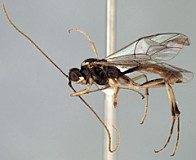See Perkins (1962: 421) for reference to the validity of Anisotacrus.
Anisotacrus Schmiedeknecht, 1913
Anisotacrus albinotus Kasparyan, 2007
Anisotacrus bipunctatus (Gravenhorst, 1829)
Anisotacrus iyoensis (Uchida, 1953)
Anisotacrus konishu Kasparyan, 2007
Anisotacrus kurilensis Kasparyan, 2007
Anisotacrus popofensis (Ashmead, 1902)
Anisotacrus spatiosus (Davis, 1897)
Anisotacrus truncatus (Davis, 1897)
Anisotacrus xanthostigma (Gravenhorst, 1829)
Anisotacrus tenellus (Holmgren, 1857) was listed as a synonym of _Anisotacrus bipunctatus (Gravenhorst, 1829) without discussion by Aubert (2000) and this synonymy needs confirmation, as is also suggested by Kasparyan and Khalaim (2007).
The above description is modified from Townes (1970), and based in part on two specimens in the Texas A&M University collection.
There are no specimens currently determined for this OTU, or those specimens determined for this OTU are not yet mappable.
This work would not have been possible without the groundwork provided by Ian Gauld’s study of the Australian and Costa Rican faunas, and we are particularly grateful for his assistance in many aspects of this study. We thank in particular David Wahl of the American Entomological Institute, Andy Bennett of the Canadian National Collection, and Gavin Broad of The Natural History Museum, London, for extended loans of the material used for this study. We also thank David Wahl and Dmitri Kasparyan for useful feedback throughout our study. Matt Yoder provided considerable assistance with databasing issues, and our use of PURLs (http://purl.oclc.org) in this regard follows the example of their use in publications by Norm Johnson. Heather Cummins, Patricia Mullins, Caitlin Nessner, Mika Cameron, and Cheryl Hyde graciously assisted us with image processing, formatting, and literature retrieval. This study was supported by the National Science Foundation’s PEET program under Grant No. DEB 0328922 and associated REU supplement nos DEB 0723663 and 0923134.
This material is based upon work at Texas A&M University supported by the National Science Foundation under Grant Number DEB 0328922 with REU supplements DEB 0723663 and 0923134. Any opinions, findings, and conclusions or recommendations expressed in this material are those of the author(s) and do not necessarily reflect the views of the National Science Foundation.




